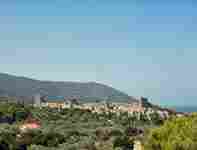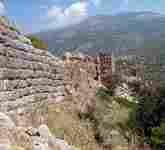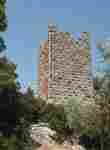.
Griechische Waffentechnologie: Katapulte, Strahlenwaffen, Kriegsschiffe, Belagerungsmaschinen
A science is said to be useful if its development tends to accentuate the existing inequalities in the distribution of wealth, or more directly promotes the destruction of human life. Godfrey Harold Hardy (1877-1947) A Mathematician’s Apology
...when the trumpet sounded, they advanced arms and charged. And then, as they went on faster and faster, at length with a shout the troops broke into a run of their own accord, in the direction of the camp. As for the barbarians, they were terribly frightened; the Cilician queen took to flight in her carriage, and the people in the market left their wares behind and took to their heels; while the Greeks with a roar of laughter came up to their camp. Now the Cilician queen was filled with admiration at beholding the brilliant appearance and the order of the Greek army (Phalanx); and Cyrus was delighted to see the terror with which the Greeks inspired the barbarians. Xenophon, Anabasis

Didrachm, Corinthian Helmet, Palms with a pair of Greaves, Text "Kamari"
Ancient Greeks invented the use of technology in warfare. It is the base of military superiority of the civilization of the West. The first such invention was the Phalanx which was used against the Persians. The Athenians produced very fast triremes. The Greeks in Sicily developed the first advanced catapults. In the period of Alexander the Great colossal siege engines were produced. Alexander introduced an army that could move very fast (even today very important) a fact which requires an organization and planning. The Greek Ptolemaic kings of Egypt produced very large ships. The wars of the Diadochi for the control of the territory conquered by Alexander the Great continued for many years. The Romans very fast acquired the Greek military technology and developed the most organized military system the world ever has seen. The small city states of Greece were intergrated in an Empire that could afford the loss of many thousands of soldiers in a battle or in catastrophical events. Pyrrhus of Epirus experienced this fact. Approximately 400000 Roman soldiers died in the Carthaginian war. Around 100000 Romans died in a storm off Cape Pachynus in 255 BC which destroyed a Roman fleet.
The Phalanx (pl. Phalanges) (Gr. Finger, anatomically the bones of the toes and fingers) (soldiers in close order), refers to the soldiers’ spears thrusting out from the main body like fingers from a palm.
The Phalanx and the Trireme ship were important for Athens to be victorious against a much larger Persian Army, but military technology was developed less by Athenians but by other Greek groups. The Phalanx is considered a Spartan invention. Sparta transformed into a militaristic society (especially due to the Messenian wars experience) in order to be able to control the much larger number of Helots and Perioikoi working for the Spartans more or less as slaves. In Italy Greeks developed catapults and ships larger than the trireme. In Macedonia Philip and later his son Alexander the Great organized the military system (Macedonian Phalanx) and also improved the artillery technology. Even if Alexander died very young his generals continued his tradition especially in Alexandria, the city founded by Alexander.
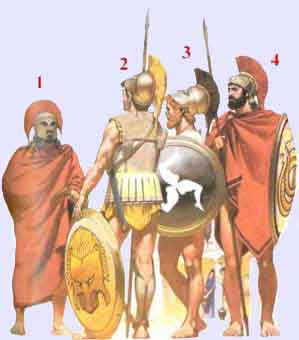
1) Spartan officer (sculpture), Hoplite 2) from Samos , shield (aspis) with lion scalp symbol, 3) from Argos (white shield with hydra), 4) from Athens (Alkmaionid clan) , Nick Sekunda, The Ancient Greeks. The Spartans used the symbol Lambda (for Lacedaemon) for their shields.
The Spartans) prided themselves upon their (long) hair, calling it the cheapest of ornaments and before going to battle they combed and dressed it with especial care, in which act Leonidas and his followers were discovered by the Persian spy before the battle of Thermopylae. William Smith (actually a comb for Spartans was considered an important equipment as the story of the Spartan general Clearchus tell us who was captured by the Persians.)
The Hoplite Armour and the military training of the Greeks was important for their victory at Marathon. 6400 Persians were killed and 192 Greeks. Today a lofty mound in Marathon contains the remains of the Athenians killed in the historic battle. Among these Kallimachos, a high ranking Athenian officer, a polemarchos, "who, being polemarch for the Athenian front, won honor from Marathon, and who furious Ares destroyed; and he left behind this memory of his honor to the children of the Athenians." (A Nike statue inscription)
Organization
Ten Strategoi ( Strategos "leader of the army", The word strategy, a long term plan of action designed to achieve a particular goal, is derived from strategos)
Taxis ( commanded by a Taxiarchos) divided in Lochoi (commanded by a Lochagos)
Some type of soldiers
Hamippos, lightly armed infantrymen supporter of a cavalryman, trying to kill the enemy horses
Psiloi, simple soldiers with spear and stones as only weapons
See also Stratos, Stratevma (Army)
- Ancient Greek Armour

- From the Pentekonter to the Trireme ship (A change of war tactic)
- Giant warships with more than 7000 crew members!
Dionysius, tyrant of Syracuse gathered skilled craftsmen, commandeering them from the cities under his control and attracting them by high wages … his purpose was to make weapons in great numbers and every kind of projectile … the catapult was invented at this time…, since the best craftsmen had been collected from everywhere into one place. The high wages as well as the numerous prizes offered to the craftsmen who were judged to be the best stimulated their zeal. Moreover, Dionysius circulated daily among the workers … and rewarded the most zealous with gifts and invited them to his table. Diodorus of Sicily, Library of History, C. H. Oldfather, transl. (Harvard Univ. Press, Cambridge, MA, 1954)
Catapults were mainly invented by Ancient Greeks. There is some evidence that probably Persians and others also used even earlier Catapults although not much is known today. Greek engineers are believed to be the designers of the most effective war engines used by the Romans.
Όπλα

Greek Hoplite training for the North Atlantic Alliance (NATO).
Scene from the so-called "Chigi" vase, a Corinthian oinochoe, Rome, Villa Giulia, c. 625 BC
- Ancient Greek Artillery Technology from Catapults to Archimedes Steam Gun
- Dionysius Repeating Catapult (The Polybolo)
- Catapults (Scientific American)
When, therefore, the Romans assaulted the walls in two places at once, fear and consternation stupefied the Syracusans, believing that nothing was able to resist that violence and those forces. But when Archimedes began to ply his engines, he at once shot against the land forces all sorts of missile weapons, and immense masses of stone that came down with incredible noise and violence, against which no man could stand; for they knocked down those upon whom they fell, in heaps, breaking all their ranks and files. In the meantime huge poles thrust out from the walls over the ships, sunk some by the great weights which they let down from on high upon them; others they lifted up into the air by an iron hand or beak like a crane’s beak, and, when they had drawn them up by the prow, and set them on end upon the poop, they plunged them to the bottom of the sea; or else the ships, drawn by engines within, and whirled about, were dashed against steep rocks that stood jutting out under the walls, with great destruction of the soldiers that were aboard them. A ship was frequently lifted up to a great height in the air (a dreadful thing to behold), and was rolled to and fro, and kept swinging, until the mariners were all thrown out, when at length it was dashed against the rocks, or let fall. Plutarch, Marcellus
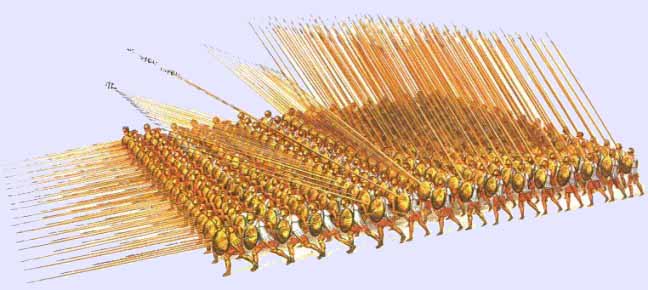
Image from P. Connolly, The Greek armies, 1978.
The basic unit, or speira, in Alexander's army. The 256 men are ranked in close order, 16 deep. In a charge, the spears, “sarissa”, of the first five ranks projected forward to break the enemy ranks - the rest of the men held their spears skywards to deflect arrows or other projectiles. Alexander also used a cavalry of 2000 men divided in groups of 250, each heavily armed. The commander of this army was Black Cleitus. It was reported that small army's move faster and the army of Alexander the Great did over forty miles a day during the pursuit of Darius in 330 BC. Armies as large as Arrian records - assuming they could survive at all - would have been incredibly slow. King Darius marched from Babylon to his base camp near in Issus within three months - a distance of 1200 kilometers or 750 miles at least. It seems that Napoleon somehow succeeded to move his army so fast that this was one of the most important reasons for his military success. A Greek soldier carried 60-70 pounds on his back. With soldiers carrying one-third the load that would be normally hauled by animals, an army of 50000 men required 6000 fewer pack animals than it would have needed, along with 240 fewer animals to haul the feed for the other animals. By requiring the soldier to carry his own equipment and food, Alexander created the lightest, most mobile, and fastest army the world had ever seen. In eleven years Alexander's army covered 11000 miles.
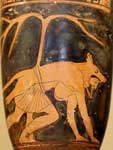
Camouflage used by Dolon as a spy
Organization, Names
- Chiliarchia (from gr. chilios 1000), a 1000 men group commanded by the chilarchos (χιλίαρχος) ( an organization of Persian origin) Hephaestion and Perdiccas were chiliarchoi
- Hetairos (companion) elite cavalryman.
- Hypaspist an armed elite guard
- Ile a squadron of cavalry commanded by the Illarches, divided into groups (a lochos), a basilike Ille (a royal unit)
- Pezetairos, infantryman
- Prodromos, scout
- A Sarissophoros carrying a sarissa (spears shorter than the sarissa were called a longhe)
- Somatophylax (from "soma" body") a body guard
- Tetrarch leader or 4 lochoi (64 men) or 1/4 of the 16*16 = 256 men of a phalanx
|
Then Palamedes, whenever he appears in tragedy, proves Agamemnon ridiculously unfit to be a general. Did you never remark how he declares that he had invented number, and had numbered the ships and set in array the ranks of the army at Troy; which implies that they had never been numbered before, and Agamemnon must be supposed literally to have been incapable of counting his own feet--how could he if he was ignorant of number? And if that is true, what sort of general must he have been? Plato, Republic |

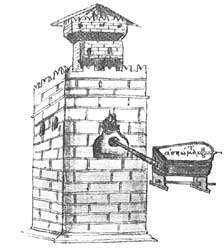
Flamethrower models a) According to Thucydides, b) Heron of Byzantium
Archimedes burning mirrors; Theory and Practice
One of the earliest antivehicle "mines" was described by military engineer Philo of Byzantium around 120 B.C., when he recommended that "in front of the advanced walls (of a city) empty earthenware jars should be buried. These are placed in an upright position with their mouths upward, stopped up with seaweed or imperishable grass, and covered with earth. Troops may then pass over the jars with impunity, (but) the engines and timber towers brought up by the enemy will sink into them." Major William C. Schneck, The Origins of Military Mines: Part II


The ditch filling tortoise of Diades,

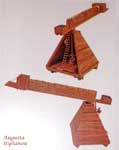
The Sambuca of Damios from Kolophon,


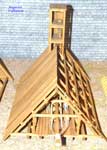

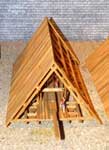
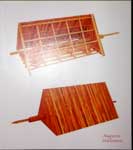
The Helepolis of Epimachos, The roofed ram of Diades, The borer ("trypanon") of Diades,

Achilles binding the wounds of his friend Patroclos, from a c. 500 BC kylix cup (now in a Museum in Berlin Germany), Sosias Painter, Patroclos wearing a cap used to make the wearing of the helmet more comfortable. Interior and Side View
The left upper arm of Patroclus is injured, and Achilles is bandaging it with a two-rolled bandage, which he is trying to bring down to extend over the elbow.Achilles was not a trained surgeon, and it will be observed, from the position of the two tails of the bandage, that he will have some difficulty when it comes to its final fastening! (Charles Singer )

Athena the Warrior with her Shield.
War is the father of all and king of all, and some he shows as gods, others as men; some he makes slaves, others free, Heraclitus
Fortification

Nic Fields, Brian Delf , Ancient Greek Fortifications 500-300 BC (Fortress) , Osprey, 2006

Fortification walls in Messene
The fortress of Aigosthena, Click to enlarge
Images of the Euryalus Fort close to Syracuse build by the order of Dionysius I
Eleutherai Fortification
Medieval Greek (Byzantine) Warfare
Catapults or Scorpiones, Ballistae, The Stringing and Tuning of Catapults, Siege Machines
The Tortoise, Hegetor's Tortoise, Measures of Defence. From Book 10, Vitruvius
----------------------------
Other Interesting stories
The first European to acquire elephants was Alexander, after subduing Porus and the power of the Indians; after his death others of the kings got them but Antigonus more than any; Pyrrhus captured his beasts in the battle with Demetrius. When on this occasion they came in sight the Romans were seized with panic, and did not believe they were animals. For although the use of ivory in arts and crafts all men obviously have known from of old, the actual beasts, before the Macedonians crossed into Asia, nobody had seen at all except the Indians themselves, the Libyans, and their neighbours. This is proved by Homer, who describes the couches and houses of the more prosperous kings as ornamented with ivory, but never mentions the beast; but if he had seen or heard about it Pausanias

A war elephant used by the Kings of Pergamon against a Gaul, Louvre
Books
Nicolas Grguric, Angus McBride (Illustrator), The Mycenaeans c.1650-1100 BC (Elite)- , Osprey Books (NY) (September 30, 2005) . ISBN: 1841768979
Duncan B. Campbell, Brian Delf (Illustrator), Greek and Roman Siege Machinery 399 BC-AD 363 (New Vanguard)- , Osprey Publishing, Limited 2003, ISBN: 1841766348
Tim Everson , Warfare in Ancient Greece: Arms and Armour from the Heroes of Homer to Alexander the Great- , Sutton Publishing 2005 ISBN 0750933186
William Gurstelle , The Art of the Catapult: Build Greek Ballistae, Roman Onagers, English Trebuchets, and More Ancient Artillery- ,Chicago Review Press (July 1, 2004) ISBN: 1556525265
Peter Connolly , GREECE AND ROME AT WAR- , Greenhill Books, ISBN: 185367303X
Adrienne Mayor, Greek Fire, Poison Arrows, and Scorpion Bombs: Biological & Chemical Warfare in the Ancient World- , Overlook Hardcover; 1st edition (September 29, 2003) , ISBN: 158567348X
Simon Anglim, Rob S. Rice, Phyllis Jestice, Scott Rusch, John Serrati, Fighting Techniques of the Ancient World (3000 B.C. to 500 A.D.): Equipment, Combat Skills, and Tactics- , Thomas Dunne Books, 2003, ISBN: 0312309325
Victor Davis Hanson , The Western Way of War: Infantry Battle in Classical Greece- , University of California Press; 2nd edition (February 11, 2000) , ISBN: 0520219112
Anthony McNicoll, N. P. Milner, A. W. McNicoll . Hellenistic Fortifications from the Aegean to the Euphrates (Oxford Monographs on Classical Archaeology)- , Oxford University Press (May, 1997) , ISBN: 019813228X
Modern Soldiers From Ancient Texts
Reports in Greek
Τα ετυμολογικά τού πολέμου
| Ancient Greece
Science, Technology , Medicine , Warfare, , Biographies , Life , Cities/Places/Maps , Arts , Literature , Philosophy ,Olympics, Mythology , History , Images Medieval Greece / Byzantine Empire Science, Technology, Arts, , Warfare , Literature, Biographies, Icons, History Modern Greece Cities, Islands, Regions, Fauna/Flora ,Biographies , History , Warfare, Science/Technology, Literature, Music , Arts , Film/Actors , Sport , Fashion --- |

